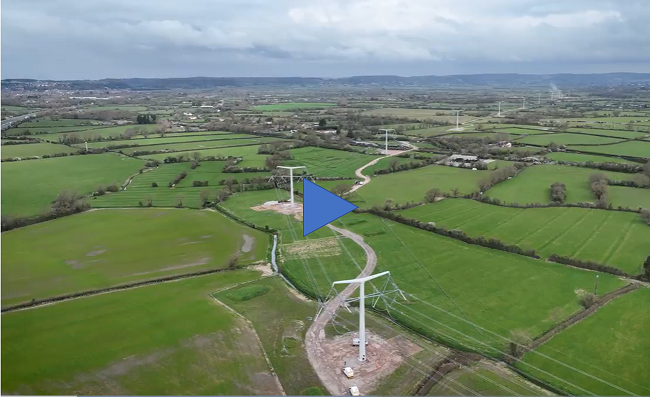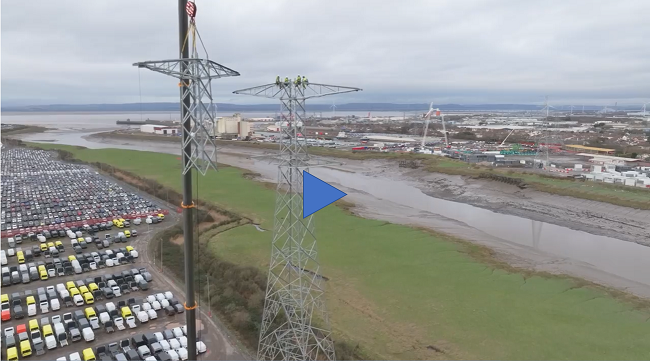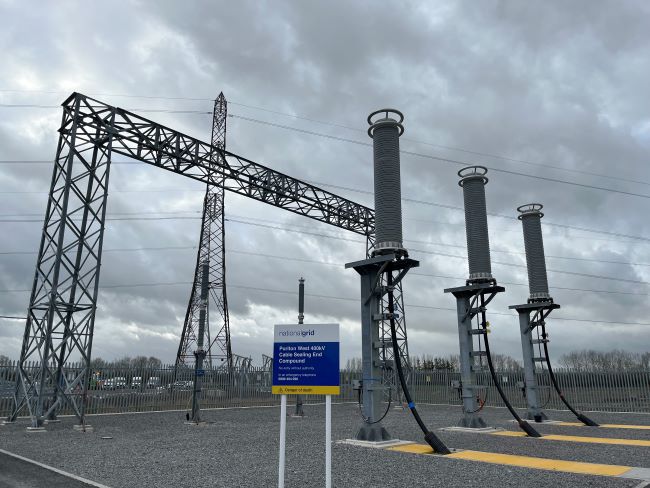 |
| Welcome to the Hinkley Connection Spring Newsletter | The past few months has seen the Hinkley Connection Project celebrate some significant milestones.
All 116 T-pylons have now had their overhead wires - or conductors - installed in a process known as stringing, with the last section being completed near Yatton. The project has also finished the remarkable build of two, new 76-metre lattice pylons at the mouth of the River Avon which has served to showcase the evolution in engineering techniques from the 1930s to the 2020s. And testing of underground cables north of Bridgwater has set the stage for full energisation of the Hinkley Connection Project by the end of this year.
Getting all our teams home safely at the end of every day is always a priority. And early in 2024 we marked over 4 million hours worked on the project whilst maintaining a world-class safety performance.
In this newsletter we also share news of how over £1.5m in community grants is supporting 100 local organisations and initiatives along the route and take a closer look at the transformation of Hewish and Puxton Village Hall. We also show how the Hinkley Connection Project has been inspiring future scientists and engineers through our science, technology, engineering and mathematics (STEM) grants.
Read on to find out more about these stories, as well as what's happening next in your area.
| |  | | All T-pylons fully wired up in major milestone for the project | National Grid has installed overhead conductors on all 116 of its new T-pylons, marking a major milestone for its Hinkley Connection Project which will bring low carbon power to six million homes and businesses across the UK.
The project spans 57km in total between National Grid’s new Shurton substation on the Hinkley Point C site and Seabank substation in Avonmouth. 48.5km of the connection is made up of overhead lines – mostly T-pylons – while an 8.5km stretch of underground cable runs through the Mendip Hills Area of Outstanding Natural Beauty.
The 'stringing' works were completed with the fixture of conductors to a T-pylon near Yatton in North Somerset. Each T-pylon supports 12 conductors, meaning that National Grid and its contractor Balfour Beatty have installed a total of 460km of power line between the 'T' structures – enough to stretch from Bridgwater to Paris.
Steven Haskayne Hinkley Connection Project Director said, “With the T-pylons fully strung, our Hinkley Connection Project is really starting to take shape. It’s a proud moment for all the teams involved, from our National Grid colleagues to our contractors, all of whom have helped us reach this milestone safely and on schedule.
“We’re grateful to all of the local communities we’ve been working alongside for their patience as our project team continues its work, which is moving us closer to a resilient and secure low carbon energy supply for millions." | | |
|
Celebrating four million hours worked
|
Early in the New Year, we were proud to celebrate a total of four million hours worked on the Hinkley Connection Project whilst maintaining a world-class safety performance.
Those hours have been put to good use, with the project achieving numerous milestones including the construction of 116 T-pylons, the installation and energisation of 8.5km of underground cables under the Mendip Hills and the removal of 249 existing pylons from the Somerset landscape.
Steven Haskayne, Project Director for National Grid commented, "The total number of working hours demonstrates the scale of the project and what it takes to deliver the critical infrastructure that will build future resilience into the network and support the UK’s net zero by 2050 ambitions. I’m proud of every moment that each team member has dedicated to the Hinkley Connection Project and what we’ve collectively achieved so far.”
|
|
|

|
| Conquering new heights for green energy | Two new 76-metre-tall lattice pylons have been built at the mouth of the River Avon near Bristol as part of the Hinkley Connection Project.
The two new pylons replace two original gentle giants - 91-metre-high pylons which were built 90 years ago - and highlight the remarkable evolution of engineering techniques and sea transportation between the 1930s and 2020s.
In the 1930s, the two original pylons were constructed panel by panel and lifted up using a lifting device called a gin pole. Workers would have used a series of pulleys and guide wires to lift pylons into place.
The pylons needed to be over 90 metres tall to allow large cargo ships to travel up and down the River Avon. Constructing pylons of this height would have taken considerable effort using the techniques available at the time.
In 2023, the removal of these two gentle giants required the latest innovative engineering techniques. A crane capable of carrying 650 tonnes needed to use a 34-metre-tall extension, called a fly jib just to reach the top of the pylons.
The new pylons are 15 metres shorter than their predecessors as modern cargo ships need less overhead clearance than those of the 1930s.
All the sections of the pylons were first built at ground level. Then, under ideal weather conditions, each section was hoisted up into position using a large crane." Check out photos from the build on the project website or - if you've a head for heights like our engineers - view stunning drone footage below. | |  |
|
Underground cables successfully tested in Bridgwater
|
As part of the Hinkley Connection project, modifications of the existing electricity transmission network near Bridgwater have seen 420 metres of overhead conductors undergrounded to enable a new section of 400kV power line connecting Hinkley Point with Melksham substation to pass overhead. Earlier this month, the underground cables were successfully tested ahead of full energisation later this year.
The works in Horsey require the installation and removal of temporary masts, two new angle towers and the building of two cable sealing end compounds, where overhead electricity lines connect onto the new section of underground cables.
The testing of the cables involved transmitting electricity at increasing levels of voltage for several minutes until reaching a max voltage of 260KV which is sustained for an hour to ensure the cables can operate safely and effectively.
Following this, the cables have passed their initial commissioning stage which is the first step to the cables being officially accepted onto the electricity network, and are now ready for full energisation along with the short section of T-pylons and conductors that run overhead.
The underground cables connect Hinkley Point to Bridgwater Substation, the overhead section tees into the line between Hinkley Point C and Bridgwater at Horsey to connect Melksham Substation also. These modifications now connect three separate lines of pylons to Hinkley Point C and, once the new power station is generating, will help provide six million homes and businesses with low carbon, homegrown energy across the UK.
Bethan Coleman, Project Manager for National Grid said, “The commissioning of the underground cables at Bridgwater is another step towards a resilient and secure supply of low carbon, homegrown energy to millions of homes and businesses across the UK."
|
|
|

|
| In your area - what's happening near you? | | As we approach the final stages of construction work in 2024, completion of the stringing works will be followed by work on testing and energisation of the new high voltage line between Sandford and Seabank later in the year. Reinstatement works are also in progress along the route. | |
We continuously update dedicated pages on the project website so you can view progress near you.
Visit the 'In Your Area' section where you'll find updates on current activity and a summary of work today and what's coming up.
|
|
 | | 100 community projects supported through £1.5m funding | National Grid's Community Grant Programme was set up to support community groups and charities in areas most impacted by National Grid's construction activity.
Since construction of the Hinkley Connection Project began in 2018, 100 community projects along the route have now received a total of £1.5 million in grants for a variety of causes which aim to improve the lives of local residents.
We've helped build a play park in Portbury, funded Portishead Wheels and Skate Park, supported the revamp of a number of guide and scout huts, helped the Frankie Howerd Trust in Loxton buy a new minibus, got low income families back on their bikes and funded counselling services. You can view the full list of grants awarded on the project website.
One of the local initiatives to receive funding is Hewish and Puxton Village Hall, it received £40,000 from National Grid first to save it from closure then to help with a revamp.
Having long served as a community hub since its opening in 1965, The hall suffered from a lack of insulation, making it freezing in winter and too hot in the summer. In addition, an asbestos roof was leaking and various ceilings were falling down. The funding allowed the community to address these issues and ensure the building was comfortable and safe for all to enjoy.
Lynda Redding, Chair of Hewish and Puxton Hall said, "National Grid's donations were not only generous but given up front which was an immense help. They have helped give the community a warm and pleasant space to socialise in. The WI ladies can now take their coats off!" | | |
 | | Inspiring half a million future scientists and engineers | Over 500,000 pupils across the south west have benefitted from £1.35 million in science, technology, engineering and mathematics (STEM) grants provided by National Grid’s Hinkley Connection Project to enable schools to buy the latest STEM equipment.
This far exceeded National Grid's aim to help 400,000 children at the start of the project.
Over 2,000 grants have been awarded to local schools along the route and used to buy equipment ranging from 3D printers and new laptops to programmable robots.
These grants are intended to spark an interest in STEM careers and inspire the next generation of engineers, project managers and workers in many other professions that are essential to realising the potential of a low carbon future.
Haygrove Secondary School in Bridgwater received funding towards a laser cutter in its Design and Technology Department. Lynne O’Hallaran, a teacher at the school, said, “The cutter enables the rapid build of prototypes, exposes our pupils to new technology and enhances creativity. It has made a huge difference to the depth and range of STEM projects students can undertake.” | | |
 |
|